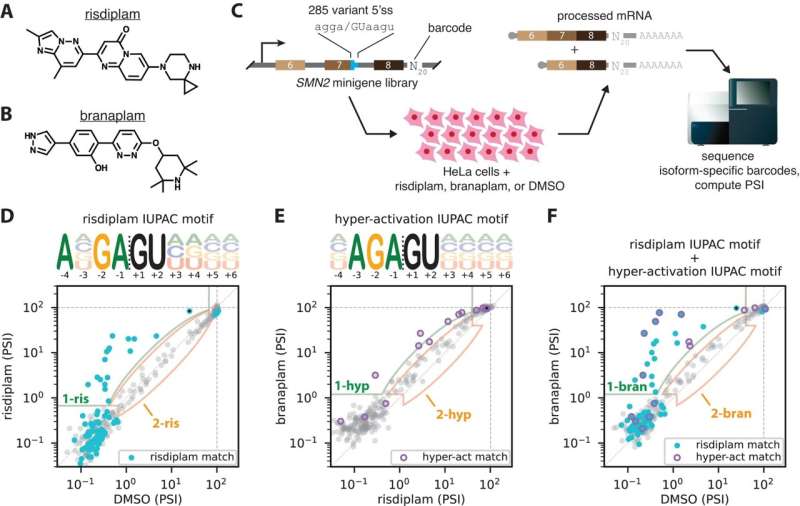This article has been reviewed according to Science X's editorial process and policies. Editors have highlighted the following attributes while ensuring the content's credibility:
fact-checked
peer-reviewed publication
trusted source
proofread
Why some RNA drugs work better than others

Spinal muscular atrophy, or SMA, is the leading genetic cause of infant death. Less than a decade ago, Cold Spring Harbor Laboratory (CSHL) Professor Adrian Krainer showed this brutal disease can be treated by tweaking a process called RNA splicing. This breakthrough resulted in Spinraza, the first effective treatment for SMA. It also opened a new frontier in drug development.
Now, CSHL research could push RNA-splicing drugs even further. CSHL Associate Professor Justin Kinney, Krainer, and postdoc Yuma Ishigami have figured out why some splicing-based drugs tend to work better than others.
RNA splicing determines which gene segments are used to build a protein. Krainer had designed Spinraza to home in on the exact spot where the drug would modify the production of a specific protein SMA patients need. Not all splice-modifying drugs are so intentionally constructed. Some have been found to change RNA splicing without scientists fully understanding how. That's true for a recently approved SMA drug, risdiplam.
The Kinney and Krainer labs analyzed risdiplam's interactions with RNA to better understand how this drug works. They also examined RNA's interaction with another drug, branaplam. The researchers measured the drugs' effects on splicing throughout the genome and on hundreds of variations of their intended targets. From there, they modeled how each drug identifies its targets among all RNA inside a cell.
Both risdiplam and branaplam alter RNA splicing to generate the protein needed to treat SMA. However, the researchers found that risdiplam is more specific. Their quantitative models explain how. In the simplest terms, branaplam binds to RNA in two different ways—whereas risdiplam only binds in one way. This finding could help researchers alter the chemical structure of branaplam so that it might someday treat Huntington's disease—a fatal, currently incurable neurodegenerative disorder.
The researchers also found something else. Combining splice-modifying drugs that target the same gene segment in different ways usually has a greater effect than either drug alone.
"You get synergistic interactions," Kinney explains. "We found synergy is a general property of splice-modifying drugs. This might provide a basis for using drug cocktails instead of individual drugs."
The finding could help researchers identify drug combinations with the potential to improve patient outcomes. And that could lead to new therapeutic strategies for SMA and other diseases. For example, the Krainer lab recently investigated RNA splicing in pancreatic cancer.
"Our new study provides insights into the action and specificity of splice-modifying drugs," Krainer says. "This should facilitate the development of more effective drugs and drug combinations for a variety of diseases."
The research is published in the journal Nature Communications.
More information: Yuma Ishigami et al, Specificity, synergy, and mechanisms of splice-modifying drugs, Nature Communications (2024). DOI: 10.1038/s41467-024-46090-5





















